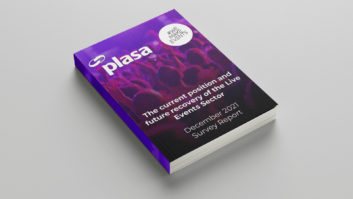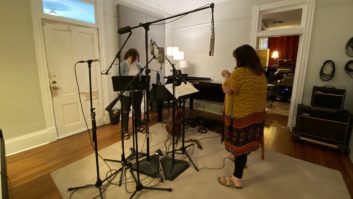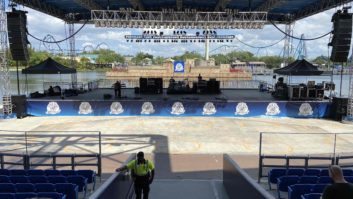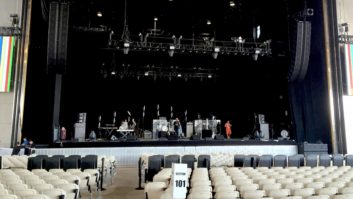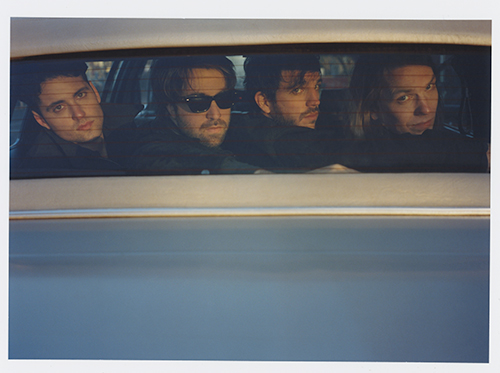
For their third album, English Graffiti, the Vaccines take on the role of matchmakers as well as musicians. The British foursome brings together longstanding producer Dave Fridmann (Flaming Lips, MGMT, Tame Impala) and newly minted Grammy winner Cole Marsden Greif-Neill (for his work on Beck’s Morning Phase) into an unlikely but very successful pairing. The Vaccines are known for their traditional approach to writing classic rock songs with the firm goal of timelessness. On English Graffiti, the group eschews that mentality, trading it in for an über-modern, experimental approach—very much of the moment, but still a rock ’n’ roll aesthetic.
The Vaccines’ principal songwriter, Justin Hayward-Young, came to Greif-Neill with songs already written with the other band members, which Greif-Neill redid into his own versions. The two then went on to write the majority of the songs on English Graffiti together.
“They brought me in to re-create the vision of the album how I saw it,” says Greif-Neill. “I would make my own demo of the songs, reimagining them. They had been working on the record for a year before I got involved. It was at a point where they could use a refreshing.”
Armed with countless songs, the Vaccines and Greif-Neill came to Fridmann’s Tarbox Road Studios in upstate New York. According to Fridmann, much of what they arrived with did not get recorded. Instead, Greif-Neill delved further into the co-songwriter role, collaborating and directing every aspect of the recording.
“It was a piecemeal approach in the sense that we tried everything at least once,” says Fridmann. “We tried as a band, we tried as individuals, we tried as a click track, we tried without a click track. We were trying to find the right approach per song.”

Fridmann draws an analogy between the Vaccines recording sessions and his wife making soup from scratch. Many, many ingredients go into the creation of the soup’s broth, all of which get thrown out. Similarly, the Vaccines do many, many recordings in various forms, with sometimes only one singular sound, such as a tambourine or a guitar riff, retained.
For these sessions, much of the equipment is set up and kept that way for the duration. In particular, two drum kits are set up with different miking schemes—one with a drier, tighter but junkier sound, another with opposite characteristics. The microphones—purposely chosen—are entirely wrong for capturing drum sounds. The toms are miked with RCA BK-6B lavalier microphones. These are paired with Altec Lansing 1591A preamps that transform them into the sound both producers are happy with. The kick is miked with an STC 4021 or “ball and biscuit” microphone. The snare drum is miked with an Electro-Voice Model 636, an omnidirectional microphone, again not the typical choice, but perfect for English Graffiti. An Altec 39A, a single mono overhead, is used for the kit and an RCA 44 for the room mic.
“There was almost no way to get a traditional sound out of what we were doing,” says Fridmann. “Even when the band used an acoustic guitar or Fender Rhodes or an organ or synths, the idea was, ‘Let’s see how we can break the mold.’”

Young flexes his vocal style, dipping into various modes over the course of English Graffiti. Four different vocal chains were determined for Young’s various personas on the album. On “Handsome,” the ball and biscuit microphone into a Neve preamp; on “Dream Lover,” it’s a vintage Sennheiser MD 421, on which Fridmann uses his Otari Concept Elite console’s preamp into a dbx 160 compressor; for cleaner phrasings, a Bock Audio 521 into a Neve 8801 preamp; and finally, a Neumann U 47 going into an Ampeg 610 mic pre is used.
In addition to directing and playing during the recording, Greif-Neill’s main input comes when he takes those recordings and edits them. Coming from a hip-hop style of production, his work takes place in Ableton Live and Pro Tools. Relying on plug-ins from Sound Toys and Valhalla (reverb), as well as Ableton’s built-in plug-ins, Greif-Neill draws heavily from his home recording background.
“The more screwed up and unusual a sound, the better,” says Greif-Neill of both his and Fridmann’s goals. “Editing and processing in Ableton gave us a broader sound palette to draw from. It was always about finding the balance of natural versus unnatural sounds, processed versus dry. But, there are performances that are completely unedited. Without those, the album would feel too produced and overwrought.”
One of the songs on English Graffiti that went through an inordinate number of facelifts from creation to completion is “(All Afternoon) In Love.” Young originally wrote the track on his own. Starting as a funky, folk-rock groove, after Greif-Neill’s re-demoing of it in Ableton, it transformed into an ’80s synth-rock ballad that the group recorded. Greif-Neill chopped and stripped away from these recordings, reprogramming the live drums by processing, distorting and making them lo-fi yet electronic-sounding.
“I can be a lot more aggressive in the original capturing of sounds if I know I’m going to be mixing it because I already know what the final result is going to be,” says Fridmann of the mixing, which he does wholly in analog on the Otari Elite. “At that stage, I just need to make sure it’s got all the energy and push and movement that we didn’t achieve through raw performance.
“The band was incredible in terms of their no compromise approach,” he continues. “They were willing to fail and keep doing it no matter how many times it took, no matter how much time we invested in any part of the song or any particular sound. They were fearless in their explorations. It was really impressive.”

